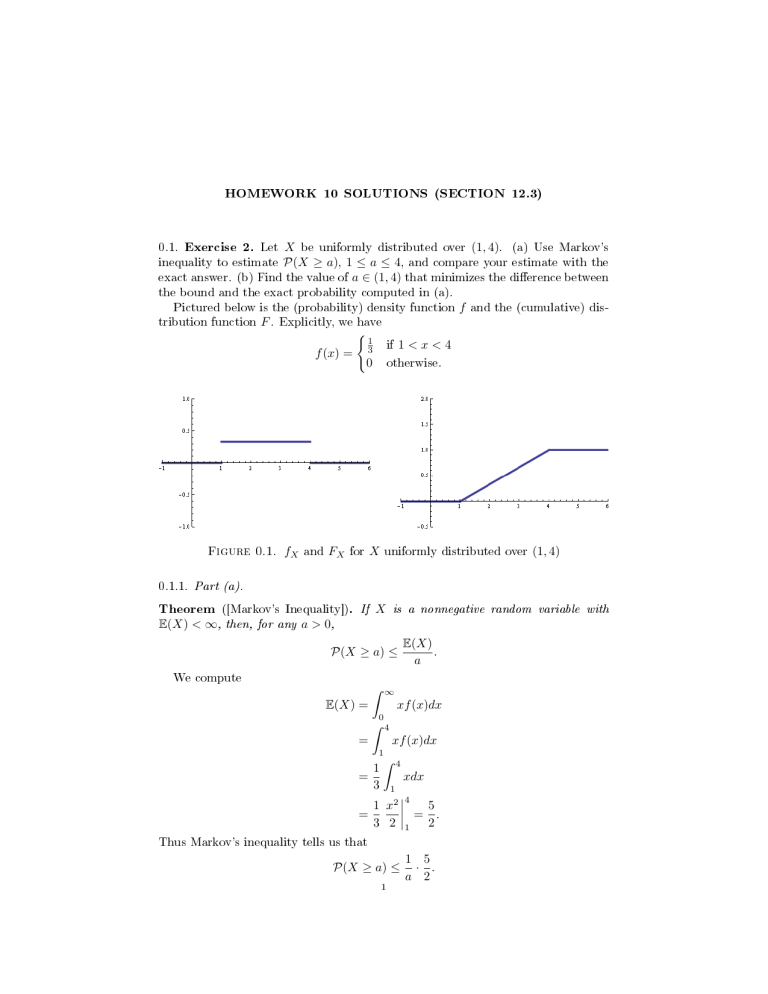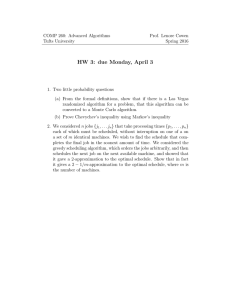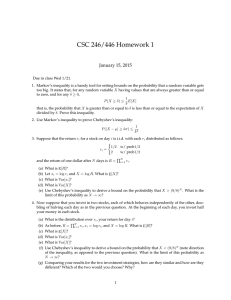
HOMEWORK 10 SOLUTIONS (SECTION 12.3) 0.1. Exercise 2. X be uniformly distributed over (1, 4). (a) Use Markov's P(X ≥ a), 1 ≤ a ≤ 4, and compare your estimate with the (b) Find the value of a ∈ (1, 4) that minimizes the dierence between Let inequality to estimate exact answer. the bound and the exact probability computed in (a). Pictured below is the (probability) density function tribution function F. ( f (x) = Figure 0.1. 0.1.1. f and the (cumulative) dis- Explicitly, we have fX and FX 1 3 1<x<4 otherwise. if 0 for X uniformly distributed over (1, 4) Part (a). Theorem ([Markov's Inequality]). E(X) < ∞, then, for any a > 0, If X is a nonnegative random variable with P(X ≥ a) ≤ We compute ˆ E(X) . a ∞ E(X) = xf (x)dx 0 ˆ 4 = xf (x)dx 1 = 1 3 ˆ 4 xdx 1 1 x2 = 3 2 4 = 1 5 . 2 Thus Markov's inequality tells us that P(X ≥ a) ≤ 1 1 5 · . a 2 HOMEWORK 10 SOLUTIONS (SECTION 12.3) In contrast, for 1 ≤ a ≤ 4, 2 we have ˆ ∞ P(X ≥ a) = f (x)dx a ˆ 4 = a 1 dx 3 1 = (4 − a). 3 FX (a) = P(X ≤ a) = 1 − P(X ≥ a). Let's look at a table for some 1 ≤ a ≤ 4 and a graph of P(X ≥ a) and a1 · 52 . With the graph, we visually Note that values of verify the application of Markov's inequality. 1 a a P(X ≥ a) · 1 1 5 2 2 2 3 5 4 5 2 5 6 1 3 1 3 5 6 4 0 5 8 5 2 (a) Comparing some (b) Comparing P(X ≥ a) (blue) and values. 1 a · 5 (red) 2 Figure 0.2 0.1.2. Part (b). Let's dene the dierence between the functions: g(x) = 1 5 1 · − (4 − a). a 2 3 Next we take a derivative and solve for critical points. We have g 0 (x) = − 5 1 + =0 2a2 3 and solving we get r a= 15 . 2 Taking the second derivative we have g 00 (x) = which is positive for all interval (1, 4). 1 ≤ a ≤ 4, and so 5 , a3 a= q 15 2 is a global minimum on the HOMEWORK 10 SOLUTIONS (SECTION 12.3) 0.2. Exercise 6. Let 3 X be standard normally distributed. Use Chebyshev's inP(|X| ≥ 1), (b) P(|X| ≥ 2), and (c) P(|X| ≥ 3). Compare equality to estimate (a) each estimate with the exact answer. Theorem ([Chebyshev's Inequality]). If X is a random variable with nite mean µ and nite variance σ 2 , then, for c > 0, P (|X − µ| ≥ c) ≤ (0.1) σ2 . c2 Below we provide a picture (Figure 0.3) of the (probability) density function and the cumulative distribution function of Figure 0.3. fX and FX for X. X standard normally distributed. We we also shade the area under the probability density functions for parts (a) and (b) (Figure 0.4). (a) P(|X| ≥ 1) (b) P(|X| ≥ 2) Figure 0.4 Part (a). 1 1 = 1 (which is true for any probability). For the actual value, we use the table to get 0.2.1. Applying 0.1 with µ = 0, σ 2 = 1, we have P(|X| ≥ 1) ≤ P(|X| ≥ 1) = 2 · 0.1587 = 0.3174. 0.2.2. Part (b). µ = 0, σ 2 = 1, we have P(|X| ≥ 2) ≤ 14 = 0.25. table to get P(|X| ≥ 2) = 2 · 0.0228 = 0.0456. Applying 0.1 with For the actual value, we use the HOMEWORK 10 SOLUTIONS (SECTION 12.3) 0.2.3. Part (c). 0.1111. 0.0028. Applying 0.1 with µ = 0, σ 2 = 1, P(|X| ≥ 3) ≤ 19 ≈ P(|X| ≥ 3) = 2 · 0.0014 = we have For the actual value, we use the table to get Remark. 4 Without using a table, we can use the 68/95/99.7% (empirical) rule to memorize that roughly 68% of a normal distribution lies within one standard deviation of the mean, 95% within two, and 99.7% within three. Thus, roughly 32% lies outside one, 5% lies outside two, and 0.3% lies outside three. Note that the actual values by taking an integral are 0.31731.../0.04550.../0.00269... 0.68268.../0.95449.../0.99730... within and outside one/two/three standard deviations of the mean. In a statistics book, there will be multiple tables and you can decrease the error of your nal answer by using the proper ones. 0.3. Exercise 12. 0.1 within How often do you have to toss a coin to determine P(heads) 0.9? of its true value with probabilty at least Method 1 (This problem is listed in 12.6.1 and so the book expects you to use Chebyshev's inequality. For 0.3.1. P X n − p ≤ 0.1 ≥ 0.9 P X n − p ≥ 0.1 ≤ 0.1. is the same as By Chebyshev's inequality, σ= p(1−p) , and worst-case scenario is when n p= 1 2 , we have P σ2 X n − p ≥ 0.1 ≤ 0.12 = p(1−p) n 0.01 100 = p(1 − p) n 100 1 1 ≤ 1− n 2 2 25 = . n Thus in order to be less than 0.1, it suces to have 25 ≤ 0.1 n or n ≥ 250. 0.3.2. Method 2 (Using 12.6.2). See my Supplement to Section 12.6 for details. In short we have P X n − p ≤ 0.1 ≥ 0.9 and so P Z≤ √ np 0.1 p(1 − p) ! ≥ 0.9 but P (Z ≤ 1.65) = 0.9505 − 0.0495 = 0.901 > 0.9 HOMEWORK 10 SOLUTIONS (SECTION 12.3) n so it suces to nd 5 such that √ Taking the worst-case scenario np 0.1 p(1 − p) ≥ 1.65. p, p = 12 , we have √ 1 n ≥ 16.5 · 2 or n ≥ 68.0625. Notice that we don't need n to be nearly as large as the sucient number of n obtained by Chebyshev's inequality. 0.4. Exercise 18. 1 0.5. Exercise 23. This wasn't one of your homeworks, but its similar to Exercise 24, and I did it above, listing it as Method 2 to Exercise 12. 0.6. Exercise 24. 1 0.7. Exercise 26. 1 0.8. Exercise 28. 1 0.9. Exercise 30. 1 0.10. Exercise 36. 1

